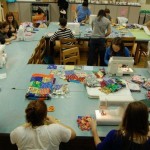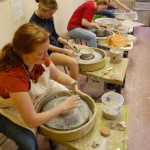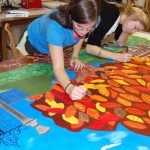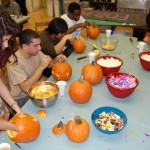Written by Deanna Boerstler in Sculpture 1
There are many alternatives to teaching for those who are looking to receive a degree in art education. However, not many of these are ever considered. It can be very beneficial for students who will be entering the work force to discuss possibilities with someone who has “been there, done that,” just as Gretchen Heuges has.
Gretchen has experienced life as a working artist, founded a nonprofit craft center, and is currently working as the main coordinator at the Bucknell University Craft center. She is also full of great advice.
Deanna Boerstler: So, to start out our interview, how did you get your start as an artist? Has it always been something that you’re interested in?
Gretchen Heuges: I’ve always had a love for the arts, all of them. I guess you could call it a fascination. I’m fascinated about how people create and the blurry line between craft and art. Everyone can express themselves in some way, and people enjoy expressing themselves. I love seeing people take part in that- finding themselves through other materials.
However, I guess I also have a bias. My mother was a painter, and she always pushed me towards art. Well, not pushed, I guess it was more of severe encouragement. There were four of us children, and I was the only one she really ever stressed going into art with. I guess she just had an inclining for my talents. The others found their own niche in the arts, however on their own terms. Without my mother encouraging me, I might’ve ended up with a similar job to one of them.
DB: It seems to make a huge difference when someone has your back with your plans for your future. Where did you end up going to school, then?
GH: I did my undergrad at the Tyler School of Art. That was before is became affiliated with Temple University. It was just this huge stone house that an elderly lady had donated to be made into an art school. At that time, it was in the suburbs of Philadelphia. It was such a close knit art community, and I loved the atmosphere there. We were all just creating and being encouraged to create. The art school was surrounded with this old stone wall with a huge stone plaque right inside the entrance. If you were on the outside looking in, the plaque said, “Temple School of Art,” but if you were in the inside the side you saw said, “The Real World.” I just think that completely sums up the atmosphere there. We knew our time wouldn’t last in this pseudo-reality that revolved around our artwork.
DB: That sounds like a great environment. What did you major in while you were there? I remember you saying you had a degree in art education…
GH: I didn’t focus on art education until graduate school. I received a bachelor’s degree of fine arts from Tyler. However, I didn’t specialize in any specific medium like most fine arts majors do. I was interested in everything. However, I did gravitate towards painting and sculpture, mostly because those were the two strongest departments. I think that happens at any art school though. Students want to take the classes with the most interesting professors. I ended up getting my degree in painting because of how many painting classes I had taken, but my interest in all different types of mediums is what ultimately led me to art education.
DB: Did you go right to graduate school after graduating from Tyler, then?
GH: No, after undergrad I moved to Allentown and taught at them Baum School of Art. I taught classes on how to teach “Saturday Art Classes”—classes that weren’t traditional, ones that might be taught at community centers on weekends. I really enjoyed teaching that class.
So, from there I moved to Lewisburg with my husband who is also an artist. He wanted to move to the middle of nowhere, so we did. We started our own nonprofit community art center. The community didn’t have anything like it, and they really enjoyed and utilized it. My husband taught the adult classes while I taught the younger students. I loved working with eight and nine year olds that still believe they can build an entire rocket ship. They just are so full of imagination.
DB: It sounds like you really enjoyed running your own community center. What ever happened to it? Why did you stop?
GH: Funds. If you look around, there’s usually some elderly lady with a love for the arts that funds something like that. We just didn’t have that. Money was tight. While we were running the art center, I worked as a free-lance tile artist. I would make my own tiles and create and install mosaics, mostly for people’s private use. I did a lot of fireplaces. I did a couple larger murals for hospitals though. The one was really special. It was for a children’s hospital, so I had the young patients draw up the design. Then, I recreated it on a large scale as a mosaic. We made it work for four years. I really do miss working with the younger children, but I can’t say I miss worrying about paying the bills and buying food. When I got offered the job at Bucknell University, working at the Craft Center, I jumped on it. It was similar to what I had been doing, but I wouldn’t have to worry so much about money anymore.
DB: When did you eventually go back to graduate school then?
GH: After working at the Craft Center for five years, I decided that I wanted to go back for my masters in Art Education. I continued to work for the Craft Center while commuting to Penn State to take part in their master’s program.
DB: Did you find it difficult to work while going to school, and do you think your experience was different from other students because of you working before furthering your education?
GH: There were definitely times when I wanted to rip my hair out—it was a lot of work. However, I would absolutely recommend waiting a while before going back to graduate school. I found that having experienced certain things that were being talked about in class gave me a deeper understanding of many of the concepts. It also added a lot of real life experience to the research that we were required to do.
DB: Overall, do have any regrets about your schooling?
GH: The one thing I do regret is not actually receiving a teaching certificate. When I went back to graduate school, I told myself to not graduate with another degree but no certificate. So, at one meeting with my advisor, I mentioned this. You know what she told me? To get a teaching certificate, I would have had to take the class that I was teaching at the time. Needless to say, I let that dream go pretty quickly.
DB: It’s a shame that you never got a teaching certificate. Would you have wanted to work as an art teaching in a public school?
GH: I don’t think that I would have wanted to work in a public school, per say. Instead I would’ve been more interested in working for a fine arts high school. There’s usually at least one in every big city. I enjoy being places where I can be absolutely surrounded by art. That’s why I enjoy the community center atmosphere. There’s always so much going on in so many different mediums.
DB: In your job now, are their certain skills that you find necessary to have that you learned in school? What is a typical day like for you?
GH: I can’t say that I have a typical work day. One thing that I find necessary is my knowledge of firing the clay projects. Some of those skills I learned at Tyler, while others I learned while creating my own tiles. The clay program is a very large part of the Craft Center, which is probably partly due to the fact that I do have a love of working with ceramics.
Other than doing the firings, I am also responsible to arranging classes for the students. Some of these are student taught, which are usually set up very last minute. It can be hectic at times. Other classes are run by professors, which are usually initiated with more time beforehand. My job is a lot of taking inventory, ordering supplies, checking emails, and making appointments. It is also very important for me to make sure that the space is clean, safe, and inviting, because many of the projects that are made here are created on a whim.
DB: That sounds like a lot of work. Is there a specific aspect that is the most rewarding? Likewise, is there an aspect that is the most challenging?
GH: I am very grateful that my job is under the Department of Student Affairs. It means that I get to work with the students directly. I get to experience the wide range of skills that the different students hold and I have to try and understand and accommodate for that. It’s a challenge, but it’s one that I enjoy. The most challenging aspect would have to be watching my senior attendants graduate. Most of them work for me for at least three of their four years here, and I enjoy watching them mature from scared, shy eighteen year olds to brave adults ready to conquer the world and share their talents.
DB: Is there any advice that you give to your graduating seniors that would apply to a young art education major as well?
GH: I always recommend to students that they experience as much as possible before shutting out other possibilities. The best thing I ever did was waiting before going back to graduate school. Instead, I took part in the real world. I experienced the things that are taught about in school. It let me find for myself what I enjoyed about art and what I didn’t like as much. From there, then, I could pick a career that I really love. I think that is important. So, what advice would I give? Get out in the world. Take summer jobs working at community art centers or summer school programs. Don’t set your mind on something until you’ve tested the waters.




